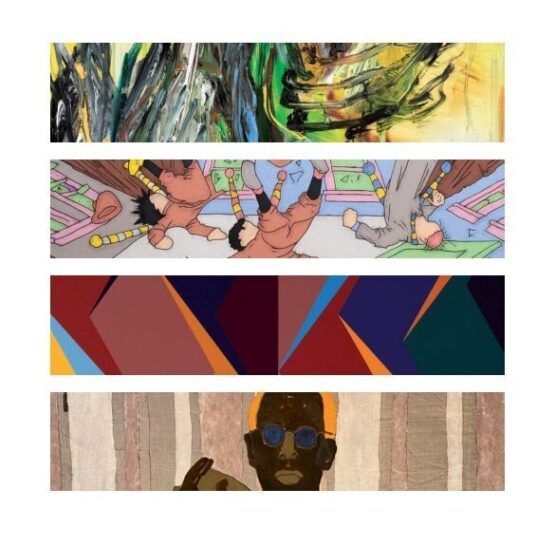Matt Mullican
As Matt Mullican states: "When I think, I think in pictures." Representing the so-called "Pictures Generation", he processes images from the mass media in his attempt to conceive and visualise an order of the world. Exploring questions of reality, perception and projection, Mullican has developed a complex system of signs, pictograms and images in his multimedia work, which reveals a wide diversity of materials including paintings and works on paper alongside digital art, installations and performances. The results can be purely abstract - like his "Untitled (Elements)" - or feature figurative elements, such as the cartoon-inspired works presented in the exhibition. Following a cosmological approach, Mullican has conceived various categories of order to classify the world, each defined with different colours. Everything has a meaning and is symbolically charged. Mullican, who taught time-related media at the Hamburg University of Fine Arts until 2019, received the Possehl Prize for International Art in Lübeck in 2022. Since 1997, MoMA PS1 has presented a long-term installation by Mullican who participated in documenta three times.
Collin Sekajugo
The processing of media images also plays a role in Collin Sekajugo’s work. The artist uses stock images, which he manipulates in painterly collages. In his series "We Come in Peace," for example, he portrays elegant-looking men who are peceived as influential personalities according to their clothing and habitus. The patterns of their suits as well as the wall decorations appear African at first glance; in fact, however, the titles of the paintings shown in the exhibition refer to New Zealand and Sri Lanka. The artist is as much concerned with globalisation processes and capitalism as he is with issues of economic, political, social and cultural identity. The strong bond with his East African home country is of great importance to Sekajugo, who was awarded the Human Rights Award Uganda in 2019. This is not only revealed in very personal narratives, but also in the use of materials such as polypropylene bags, denim or other found objects that typically occur in his homeland communities. In 2022, the Uganda National Pavilion at the Venice Biennale featured the work of Collin Sekajugo alongside Acaye Kerunen; it was honoured with a special mention.
Odili Donald Odita combines both Western and African influences, having grown up in the USA as the son of African war refugees and drawing equally from both cultures. He is committed to Geometric Abstraction and sees himself primarily as a successor to black abstract artists from the 1970s and 1980s, including Alvin D. Loving, Frank Bowling, Howardena Pindell and Edward Clark. Depicted in various hues, the fragmented formations stand out for their intensity creating a vivid rhythm through principles of multiplication. While Odita's works reveals parallels to Op Art on the one hand, his visual language is partly influenced by African forms on the other. Furthermore, the artist sees colour as an ideal means to reflect the complexity of the world and to create meaning. Odita describes his approach as follows: “The organisation and patterning in the paintings are of my own design. I continue to explore in the paintings a metaphoric ability to address the human condition through pattern, structure and design, as well as for its possibility to trigger memory. The colours I use are personal: they reflect the collection of visions from my travels locally and globally.” With poetic titles such as "Sunrise", "Candle Light" or "Day Light", his paintings evoke subjective ideas and emotions; in other works, however, Odita takes up social and political themes. His art can be found in renowned collections such as the Philadelphia Museum of Art, New Orleans Museum of Art, San Francisco Museum of Art or the Pérez Art Museum, Miami.
Jenny Carlsson Grip
The work of Jenny Carlsson Grip shows a completely different aesthetic approach. Her visual worlds, which are possibly reminiscent of the painterly tradition of a Per Kirkeby, express gestural power, immediacy and spontaneity. The fact that the artist actively uses her hands is not only evident from the clear traces in her paintings, but is also mentioned in the titles: "Fingrars väsen (The Nature of Fingers)", complemented by "Urålder (Eye of the Forest)" or "Skogsöga (Sea urchin)", for example. The fusion of body and nature seems to be omnipresent. In addition to fingers and hands, brushes, palette knives and scrapers are among Carlsson Grip's painting tools, which she uses to capture her raw and impetuous compositions. The depicted subjects are by no means clearly identifiable; they rather convey a unique mood. The artist's close connection with the landscape surrounding her is always palpable. While in earlier years Carlsson Grip only made sketches in nature, it has now become her second studio. Indeed, her works reflect the deep rootedness with her home and the soil; the paintings become manifestations of her identity. Currently, Falsterbo Konsthall in Sweden is presenting a solo exhibition of Jenny Carlsson Grip.
